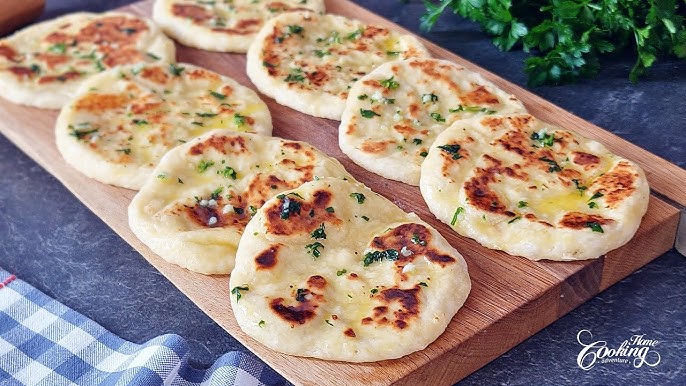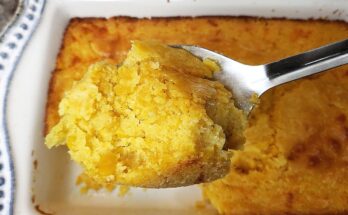Flatbread Recipe: Flatbread is one of the most versatile and ancient forms of bread, enjoyed by cultures across the globe. From soft pita bread in the Mediterranean to crispy naan in India, flatbread has made its mark as a staple food.
Its simplicity makes it perfect for quick meals, wraps, or dipping into flavorful sauces. Historically, flatbreads were baked over open flames, making them easy to prepare with minimal ingredients.
The best part? Making flatbread at home allows you to control the ingredients, ensuring it’s healthy, fresh, and free from preservatives.
Benefits of Making Flatbread at Home
Why make flatbread at home when store-bought options are available? Let’s explore the reasons:
- Health Benefits: Homemade flatbread eliminates preservatives and artificial additives. You can use whole-grain flour or gluten-free alternatives for a healthier version.
- Cost-Effective: Flatbread is budget-friendly. With just flour, water, and salt, you can create batches without breaking the bank.
- Customizable: Add herbs, garlic, or even cheese to customize the flavor according to your preference.
- Freshness Guaranteed: Unlike store-bought bread, homemade flatbread can be served fresh and warm straight from your stovetop or oven.
Whether you’re preparing a quick snack or a meal accompaniment, homemade flatbread is always a winner!
Essential Ingredients for Flatbread
Creating flatbread requires just a handful of basic ingredients, most of which are already available in your pantry.
Primary Ingredients:
- Flour: All-purpose flour is most commonly used, but you can also opt for whole wheat or gluten-free flour.
- Water: Lukewarm water helps activate the gluten, making the dough more elastic.
- Salt: Enhances flavor and strengthens the dough structure.
- Olive Oil or Butter: Adds softness and richness to the flatbread.
Optional Add-ons and Variations:
- Garlic Powder or Fresh Garlic: For extra flavor.
- Herbs like Oregano, Basil, or Thyme: Ideal for seasoned flatbreads.
- Seeds (Sesame, Nigella, or Flax): Add crunch and nutritional value.
- Cheese or Yogurt: For softer and richer dough.
Customizing the ingredients allows you to create flatbreads for every occasion—whether it’s a quick snack or a fancy dinner side.
Tools and Equipment Needed
Before diving into the recipe, gather the necessary tools:
Basic Kitchen Tools:
- Mixing Bowl: For preparing the dough.
- Rolling Pin: To flatten the dough evenly.
- Measuring Cups and Spoons: For accurate ingredient measurements.
- Skillet or Griddle Pan: Ideal for cooking flatbread on the stovetop.
Advanced Tools for Convenience:
- Stand Mixer: For faster dough preparation.
- Pastry Brush: To apply oil or butter evenly.
- Pizza Cutter: For slicing flatbread into portions.
Having these tools ready will make the preparation process smooth and enjoyable.
Step-by-Step Flatbread Recipe
Let’s dive into the recipe step-by-step for a foolproof flatbread!
Step 1: Preparation of Dough
- Combine Dry Ingredients: In a large mixing bowl, add 2 cups of flour, 1 teaspoon of salt, and any optional seasonings.
- Add Wet Ingredients: Gradually add 3/4 cup of lukewarm water and 1 tablespoon of olive oil.
- Mix and Knead: Stir the mixture until it forms a dough. Knead on a floured surface for about 5-7 minutes until smooth and elastic.
Step 2: Resting the Dough
- Cover and Rest: Place the dough in a lightly oiled bowl, cover with a damp cloth, and let it rest for 20-30 minutes.
- Why Resting is Important? Resting allows the gluten to relax, making the dough easier to roll out and improving the texture.
This preparation ensures your flatbread is soft, pliable, and ready for the next step—rolling and cooking!
Rolling and Shaping the Flatbread
Achieving the perfect shape and thickness is crucial for a balanced flatbread.
Techniques for Perfect Shape:
- Divide the Dough: After resting, divide the dough into equal-sized balls (about 6-8 pieces).
- Flatten Each Ball: Use a rolling pin to roll out each piece into a circle, approximately 6-8 inches in diameter.
- Maintain Uniform Thickness: Aim for about 1/8 inch thickness to ensure even cooking.
Common Mistakes to Avoid:
- Too Thick Dough: Leads to undercooked centers.
- Over-Rolling: Causes the dough to become tough and chewy.
- Uneven Thickness: Results in inconsistent cooking.
Mastering these steps guarantees flatbreads that look and taste amazing!
Cooking Methods for Flatbread
Flatbread can be cooked in several ways, depending on the tools available in your kitchen. Here are two popular methods:
Stovetop Cooking Method:
- Preheat the Pan: Heat a skillet or griddle over medium-high heat. Ensure it’s evenly hot to prevent burning.
- Place the Flatbread: Lay one rolled-out dough piece on the skillet.
- Cook and Flip: Cook for about 1-2 minutes until bubbles form, then flip and cook the other side for another minute.
- Brush with Butter or Oil: For added flavor, brush the cooked flatbread with melted butter or olive oil before serving.
This method is quick and effective, especially when you want warm flatbreads in minutes.
Oven-Baked Flatbread:
- Preheat the Oven: Heat the oven to 475°F (245°C). Place a baking sheet or pizza stone inside to heat up.
- Prepare the Flatbread: Place the rolled dough onto parchment paper for easy transfer.
- Bake Until Golden: Bake each flatbread for 5-7 minutes or until puffed and golden brown.
- Optional Topping: Sprinkle with fresh herbs or cheese right after removing from the oven.
The oven method gives a slightly crispier texture and works well for larger batches.
Flavored Variations of Flatbread
Flatbread can be more than just plain bread. Enhance its flavor with these creative variations:
Garlic Herb Flatbread:
- Mix minced garlic and dried herbs (oregano, parsley) into the dough before kneading.
- Brush with garlic-infused butter right after cooking for an aromatic touch.
Spicy Chili Flatbread:
- Add chili flakes or finely chopped fresh chilies to the dough.
- Pair it with a cooling yogurt dip for balance.
These small additions can elevate your flatbread from simple to sensational.
Stuffed Flatbread Ideas
For a heartier meal, try stuffing your flatbread with delicious fillings.
Cheese-Stuffed Flatbread:
- Roll out the dough, place shredded mozzarella or feta cheese in the center, and fold it over before rolling again.
- Cook as usual, ensuring the cheese melts and oozes out slightly for extra indulgence.
Vegetable-Filled Flatbread:
- Mix finely chopped spinach, onions, and herbs, then spread the mixture on half of the dough before folding and sealing it.
- Cook on a stovetop or bake in the oven.
Stuffed flatbreads are versatile and can be customized with your favorite ingredients.
Gluten-Free and Vegan Options
Flatbread can be adapted to dietary needs without sacrificing flavor or texture.
Gluten-Free Flatbread:
- Replace all-purpose flour with gluten-free flour or a blend like almond or oat flour.
- Add a pinch of xanthan gum to help bind the dough.
Vegan-Friendly Recipe:
- Substitute yogurt or butter with plant-based alternatives like coconut yogurt or vegan margarine.
- Ensure your flour and other ingredients are certified vegan.
These substitutions ensure everyone can enjoy this timeless treat, regardless of dietary restrictions.
Serving Suggestions for Flatbread
Flatbread is incredibly versatile, pairing well with countless dishes:
Side Dishes and Dips:
- Hummus: A classic Mediterranean pairing.
- Tzatziki Sauce: A refreshing yogurt-based dip with cucumber and garlic.
- Curry Dishes: Ideal for soaking up rich and spicy sauces.
Pairing with Soups and Salads:
- Serve with hearty soups like lentil or tomato bisque.
- Use flatbread as a side for fresh salads, such as Greek or Caesar.
Flatbread effortlessly complements both simple and elaborate meals.
Storing and Reheating Flatbread
If you have leftovers, here’s how to keep your flatbread fresh:
Best Storage Practices:
- Store cooled flatbreads in an airtight container or resealable bag.
- Keep them at room temperature for up to 2 days or refrigerate for up to a week.
Reheating Tips for Freshness:
- Stovetop: Reheat flatbread in a skillet over low heat for 1-2 minutes per side.
- Oven: Wrap in foil and bake at 350°F (175°C) for 5-7 minutes.
- Microwave: Heat for 15-20 seconds, but be cautious to avoid making it rubbery.
Proper storage and reheating will preserve the flavor and texture of your flatbread.
Health Tips for Eating Flatbread
Enjoy flatbread without guilt by following these health tips:
- Portion Control: Limit your intake to 1-2 pieces per meal, especially if paired with carb-heavy sides.
- Choose Whole Grains: Opt for whole wheat flour for added fiber and nutrients.
- Balance Your Meal: Pair flatbread with protein-rich dishes and vegetables for a well-rounded plate.
By making small adjustments, you can turn flatbread into a healthy and satisfying addition to your diet.
Common Problems and Troubleshooting
Even the simplest recipes can face challenges. Here are some solutions:
Dough Issues:
- Too Sticky: Add small amounts of flour while kneading until the dough becomes manageable.
- Too Dry: Add a teaspoon of water at a time to rehydrate the dough.
Cooking Problems:
- Flatbread Doesn’t Puff: Ensure your skillet or oven is sufficiently hot. Under-kneading can also be a culprit.
- Burnt Spots: Reduce heat or cook for shorter durations, flipping frequently.
Addressing these issues will make your flatbread-making journey smoother.
FAQs about Flatbread Recipe
1. What ingredients are needed for a basic flatbread recipe?
A basic flatbread recipe typically requires just a few simple ingredients: flour (all-purpose or whole wheat), water, salt, and sometimes yeast or baking powder for leavening. You can also add olive oil for a softer texture and herbs or spices for flavor.
2. Do I need yeast to make flatbread?
No, yeast is not essential for making flatbread. Many flatbread recipes are yeast-free, relying on baking powder or no leavening agents at all, which makes them quicker and easier to prepare.
3. How do I ensure my flatbread stays soft?
To keep flatbread soft, cover it with a clean kitchen towel as it cools after cooking. This traps steam and keeps the bread moist. Adding a small amount of oil to the dough can also help maintain softness.
4. Can I make flatbread gluten-free?
Yes, you can make gluten-free flatbread by substituting the all-purpose flour with a gluten-free flour blend designed for baking. Ensure all other ingredients added (like baking powder) are gluten-free.
5. What are some common toppings or fillings for flatbread?
Flatbreads can be topped or filled with a variety of ingredients. Popular options include garlic butter, cheese, herbs, vegetables like onions and peppers, or even meats such as chicken or lamb.
6. Is it possible to make flatbread on a stovetop?
Absolutely! Flatbread can easily be cooked on a stovetop. Simply preheat a skillet or griddle over medium heat, place your rolled-out dough on the surface, and cook until it’s golden and puffy, then flip to cook the other side.
7. How can I store leftover flatbread?
Leftover flatbread should be stored in an airtight container or wrapped tightly in foil or plastic wrap. It can be kept at room temperature for a couple of days or refrigerated for up to a week. Reheat in a skillet or oven for best results.
8. Can flatbread dough be made in advance?
Yes, flatbread dough can be prepared in advance. Keep it covered in the refrigerator for up to 2 days. Let it come to room temperature before rolling and cooking.
Conclusion
Flatbread is a simple yet rewarding recipe to master. By following these steps, you can create soft, flavorful flatbreads tailored to your taste. Don’t be afraid to experiment with different flours, flavors, and fillings to make the recipe truly yours.
Once you’ve perfected the technique, flatbread will become a staple in your kitchen—perfect for every meal!



